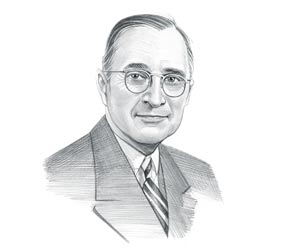|
|
|
|
|
The Taft Hartley Act was sponsored by the Conservative Senator Robert A. Taft of Ohio and Representative Fred A. Hartley of New Jersey to establish control of labor disputes and provide remedies for unfair labor practices by unions that impaired the free flow of commerce growing out of labor disputes. In 1946, the Republican Party had taken control of both houses of Congress. The Democratic President Truman vetoed the act, but the law was passed over his veto. What did the Taft Hartley Act do? The Taft Hartley Act curbed the power of the Unions by outlawing the 'closed shop' system and opened up jobs to non-union members. It banned jurisdictional strikes It prohibited the 'featherbedding' or making work' system that limited of worker productivity. The law also banned unions from using their funds to support political campaigns. When was the Taft Hartley Act passed? The Taft Hartley Act was passed on June 23, 1947 at the start of the Cold War, during the Red Scare and the wave of anti-communist hysteria. What was the purpose of the Taft Hartley Act? The Taft Hartley Act was passed to equalize the powers of management and labor and to restructure the National Labor Relations Board (NLRB). Opposition to the Taft Hartley Act: The Taft Hartley bill was denounced by unions as a "Slave Labor Act" Facts about
Taft Hartley Act Following WW2 the years leading up to the passage of the Taft Hartley Act were some of the worst in labor history, in terms of strikes Tension among labor unions, employees, and employers intensified as the rise in post war prices led to increased inflation. As the cost of living rose, workers across the nation went on strike for higher pay. As the number of strikes and labor unrest increased and prices continued to rise. Americans were demanding action and there were cries to limit the power of labor unions to reduce the number of strikes that were crippling the nation The nation was gripped in the second Red Scare and the early events of the Cold War brought about a wave wave of anti-communist hysteria. Unions began to be feared as harbors for Communist sympathizers and union leaders were being labeled as "Reds" or "Bolshies". This period in history also gave rise to McCarthyism. The 1947 Taft Hartley law (Labor-Management Relations Act) impose limits on labor's ability to strike and prohibiting radicals from Union leadership. The law included a list of prohibited actions, referred to as unfair labor practices, on the part of unions in order to balance the provisions of the Wagner Act which had only prohibited unfair labor practices committed by employers. Jurisdictional Strikes: Jurisdictional strikes and sympathy strikes or secondary boycotts were outlawed by the Taft–Hartley Act. A Jurisdictional strike is a strike resulting from a dispute between the members of different unions over work assignments. Strikes: The amendments required unions and employers to give 60 days notice to each other and other official bodies before they undertook strikes in pursuit of a new collective bargaining agreement The Taft Hartley Act authorized the President to intervene in actual or potential strikes that would result in a national emergency Strikes: The law also prohibited federal employees from striking Section 14(b) of the Taft Hartley Act affirmed the right of states to enact 'Right to Work' laws. A Right to Work law guarantees that no one can be compelled, as a condition of employment, to join or not to join a union, nor to pay dues to a labor union. Union Funds: The law banned unions from using their funds to support political campaigns. Closed Shops: The 'closed shop' system was prohibited, opening up jobs to non-union members. Anti-communism: The anti-communist hysteria was reflected in the Taft Hartley Act which contained an anti-Communist clause that required union leaders to take an oath stating that they were not communists. The law revised the free speech policy of the Wagner Act to allow employers to deliver anti-union messages in the workplace. Supervisors: The law allowed employers to terminate the employment of supervisors who engaged in union activities or did not support the employer's stance. The bill was denounced by unions as a "Slave Labor" law protesting that it wiped out the gains that Unions had made since 1933 and appealed to President Truman to veto the legislation The Democratic President Truman vetoed the act, but the Republican Party who had taken control of both houses of Congress in 1946, which enabled the passage of the legislation to be passed over his veto. Twenty-eight Democratic members of Congress declared it a "new guarantee of industrial slavery." Federal courts have upheld major provisions of the Taft Hartley Labor Act, with the exception of the clauses about political expenditures. Attempts to repeal the law have been unsuccessful, but the Landrum-Griffin Act (1959), officially known as the Labor-Management Reporting and Disclosure Act, amended some features of the Taft Hartley Act. |
| US American History |
| 1945-1993: Cold War Era |
|
|
|
|
|
First Published2016-04-19 | |||
|
Updated 2018-01-01 |
Publisher
Siteseen Limited
| ||
|
|

